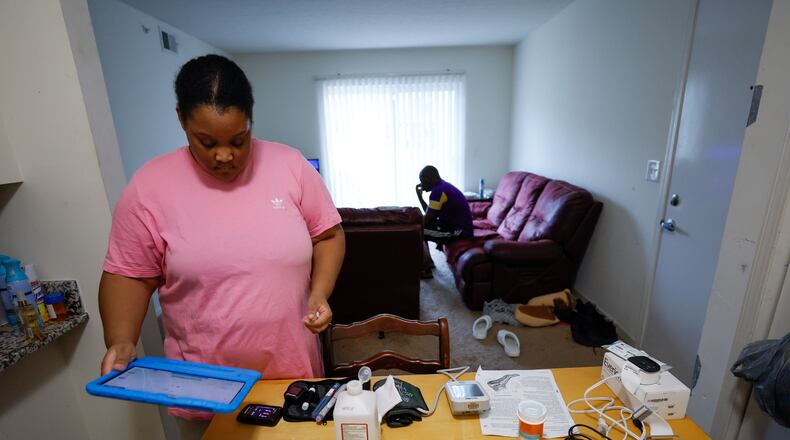Sitting in her apartment in Hephzibah near Augusta, Asia Daniels slid the blood pressure cuff on her arm just as hospital workers taught her. She made note of her vitals. Then, without leaving her home, she sent the information to nurses half an hour away.
Daniels is one of about 30 patients being treated remotely by Wellstar MCG Health, formerly known as Augusta University Medical Center, at any given time in a program known as “Virtual Care at Home.” The “telemedicine” patients relay information on their health to medical personnel via virtual care tablets. Without the telehealth service, she said, she would have been stuck with the options of having no care or taking a trip back to the emergency room.
“It’s been amazing,” Daniels said. “Ever since I got out of the hospital, I felt confident with it because I feel like I’m not alone. I know people who get out of the hospital and go home without virtual care. They feel kind of lost.”
Some state officials and her caregivers at the Medical College of Georgia and Wellstar MCG Health hope they are the vanguard of a revolution in the state.
For 20 years, predictions have swirled that internet connections will bring quality health care to far reaches of the state plagued with few medical resources. Now, with the vast changes in health care brought about by the pandemic, telehealth is gaining momentum like never before.
The need is clear: In Georgia, the ratio of doctors — 23 doctors per 10,000 residents — ranks well below the nation’s average, according to federal data, but in rural areas that number plummets by more than half. As of 2020, nine counties in Georgia had no doctor at all.
The pandemic changed attitudes. Both the public and health workers are more open to telehealth. It also sped innovation and advanced technology. After years of discussion, Georgia broadband is finally being expanded. The federal government just gave Georgia more than $400 million to spread high-speed internet across the state. And this year, just as the Augusta Virtual Care at Home initiative hit its stride, a major Georgia health system with statewide ambitions — Wellstar — acquired the hospital, and the ability to work with the college’s doctors and medical trainees. That means more resources to offer telehealth to more patients if administrators choose to do so.
The University System of Georgia, which oversees the Medical College of Georgia, touted just such hopes in June as it made the case to hand over the hospital’s management to Wellstar in August.
“With the digital medical (electronic record-keeping system) and the telehealth that’s coming here,” said University System Chancellor Sonny Perdue, “the opportunities I think are abounding for our state.”
State Sen. Steve Gooch, R-Dahlonega, has worked for years for this moment of internet expansion. “We believe 70% to 90% of every home in Georgia will be (internet) connected within the next three years,” Gooch said.
“An inflection point”
Wellstar MCG Health has two programs underway: Virtual Care at Home, which connects the hospital with patients like Daniels who have been recently discharged, and one that connects Wellstar MCG Health with 16 rural hospitals across the state, called the Rural Virtual Care Network.
Dr. Matt Lyon, director of MCG’s Center for Telehealth, which studies virtual care and trains medical students on it, acknowledged the long years of big pronouncements on telehealth, followed by slow progress.
From Lyon’s perspective, doctors’ attitudes against telehealth have been a barrier. As much as the pandemic, he credits the advent of iPhone and its FaceTime video chat function in advancing the technology and making people comfortable with it.
“We’re at an inflection point right now,” he said. “Money spent in the past really bought clunky gear that was very hard to use. You needed to be an IT person to use it. And physicians just don’t have the time or the background to deal with that.”
“Now we’re getting into where people are building technology that is easier to use, both for the clinician and for the patient. And we’re also starting to understand the strategies that help make it viable.”
Credit: Michael Holahan
Credit: Michael Holahan
There’s still a long way to go. Advocates for telemedicine have long dreamed that one day a patient who starts having symptoms at home anywhere in rural Georgia could dial up care from skilled doctors and nurses anywhere in the state. That dream is still distant: The same patients who would have a hard time finding a ride to the hospital also may not have a home computer, and may not be able to pay for the new high-speed internet.
But as a starting point, hospitals have learned to do telemedicine with each other, hospital-to-hospital. They have identified certain conditions and diseases where those connections are most useful, like with strokes. That technology has swept the state.
Wellstar is just one of many systems connecting high-tech metro hospitals to distant rural hospitals. One of the state’s networks includes Crisp Regional Hospital in central south Georgia. Dr. David Cox is medical director over both emergency medicine and hospitalist medicine there, where he does both those jobs and doesn’t have a wealth of specialists. That raises concerns when a complicated patient might have to be sent to another facility, costing the patient time and the hospital revenue.
But now, Cox has telemedicine. Last month he had a child in diabetic ketoacidosis, a highly dangerous condition that called for a pediatric specialist.
So Crisp Regional connected the patient and Cox to a specialist at Children’s Healthcare of Atlanta. As Cox followed the specialist’s instructions examining the patient, the doctor in Atlanta could see the child and their lab results. He gave his recommendations. There was no need for transport hours away, and the patient got the highest-level care possible, in Crisp County.
“The patient walked out the next day,” Cox said.
Such hospital-to-hospital telemedicine is saving regional hospitals, said Lyon.
From hospital to home - for a few
Despite the successes, it doesn’t quite add up to the hoped-for revolution. An ultimate goal for telehealth is moving high-quality care into patients’ homes anywhere.
The Virtual Care at Home program that Daniels is on with the Augusta hospital is a baby step. Besides requirements for an internet connection, the right equipment is needed for patients to take their own vital signs.
Wellstar MCG Health’s program sent Daniels home from the hospital, then sent a special paramedic to set up the gear and give her instructions. The hospital has learned those steps are essential for the patient to remember what to do.
Credit: Miguel Martinez
Credit: Miguel Martinez
In addition, for the many rural patients who have mobile homes with just cell phone internet, the home’s metal roof would block the internet signal, Lyon said. The program has learned to set up internet routers for cell phone signals in mobile home windows.
And then there’s the shortage of doctors and nurses. Augusta has assured that patients like Daniels are on a care team’s schedule so she can get the access she needs to her providers. But if every patient in the state had her access, the same shortage that makes it hard to get an appointment at a clinic would also make it hard to instant message with a doctor.
A goal of the program is to reduce “readmissions” to the hospital — meaning a patient was hospitalized and then sent home, but the problem recurred and they needed to come back within 30 days.
For Kathy Olson, the program has been a godsend. She is caretaker to her husband, a virtual care patient with a degenerative brain disease. Her husband recently had a dangerous infection that caused him to be hospitalized. Once he was sent home, his telehealth services ensured he didn’t need to return.
“You have a team at your disposal every minute of the day, day or night,” Olson said. “I can go to that tablet. I can put a message in to my nurse who’s already introduced herself for her shift.”
Strangely enough, both Olson and Daniels love the Virtual Care at Home program for how close by they feel to their nurses and doctors. It’s a world apart from dealing with in-person clinics and doctor’s offices. When they have a concern, they message and hear back from their caregiver within a half hour.
All that from the comfort of their home, which is therapeutic for her husband and saves him anxiety.
“Say Bob is now spiking a fever of 101.2,” Olson said. “I can know for a certainty that within probably less than a half an hour I’m going to get a call from the nurse (and) she’s going to say, ‘What’s going on?’ and ‘What does his urine look like? You know, I see he has a fever. Let’s check his blood pressure.’ She will guide you.”
About the Author
Keep Reading
The Latest
Featured


